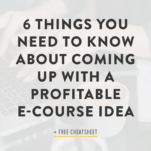If you’re at all invested in the online world, then you’ve probably started to notice something major: online courses are HUGELY popular. Even celebrities are creating them.
Since online courses are becoming more mainstream, does that mean there isn’t any space left for you to create and sell a successful course?
Heck.freaking.no.

Actually, the fact that online courses are becoming more widespread is a good thing, as it’s growing the pool of people who would want to buy an online course in the first place.
Think about it — how many of your friends or family would know what an online course is? Most of the time when I tell people that I “create courses for a living,” I get puzzled looks. So, now that more people are learning about online courses , more and more people will be interested in buying them, too!
Bottom line: If you’ve ever wanted to create online courses for living (or even just for some extra side cash!), then now is the time to do it. In fact, since launching my first course 8 months ago, my business has earned $400,000. That’s nearly half a million dollars. In less than a year. BANANAS.
Now, I know what you want to ask me: “But how do I come up with a topic that people will actually pay ME for?!” Excellent question, young grasshopper. In today’s post, I’m uncovering all the details you’ll want to know in order to come up with a profitable online course topic of your own.
The Components of a Killer Online Course Idea

Your Knowledge: This is whatever kind of knowledge or expertise you have and can teach to someone else. Now, go easy on yourself, my friend! You know a LOT more than you give yourself credit for. Just think of it this way: aim to teach people who are where you were 1-2 years ago. What did you learn in that amount of time? Think about how useful it would be to someone who is where you used to be!
Your Passion: Now, just because you’re knowledgeable about knitting doesn’t mean you have to create an online course all about knitting. The sweet spot for courses is being able to find where your knowledge and experience intersects with your passion. Which types of questions do you love answering? Which topics fire you up?
Your Audience’s Problem: Now THIS is a biggie and it’s what we’ll be focusing on quite a bit today. What specific problem is your audience having and how can you help them with it?
As you can see in the graphic above, your course topic exists at the intersection of your knowledge, your passion, and their problem. We talk more about this in my course, the The Profitable Creator, too. With a little soul-searching, I know you can uncover what you’re knowledgeable in and what you’re passionate about…but to find out what your audience is struggling with, you’ll need to do some research. How? Let’s explore a few key ways to do it!
How to Find an Online Course Topic People Will Pay You For
1. Use Facebook Groups
Facebook groups are HUGE for doing target market research and I use them regularly to see what kinds of courses, blog posts, and webinars would benefit my audience most.
Here’s how you can use Facebook groups to do some serious research:
A) Find groups where your target audience is hanging out.
“Um, sounds cool, Melyssa, but how do I do that?” There are a couple ways to go about this. My recommendation? Use Google. Search for something like this:
“Best Facebook Groups (INSERT NICHE OR TOPIC HERE)”
Now, instead of clicking the direct links to different Facebook groups, look for blog posts or articles that other people wrote with their selection of the best groups on that topic. For example, “10 Best Facebook Groups for Pet Lovers.”
That way, you’re not just joining random groups, hoping that they will be great. There are a ton of spammy and unhelpful groups on Facebook, so by taking other people’s recommendations, you’re able to join groups that have a stamp of approval from at least one source.
Don’t make this mistake! When doing research, many people will join groups with their PEERS. Rather, you want to join groups where your AUDIENCE hangs out. So, if I were a graphic designer who mainly works with Etsy shops, I wouldn’t join a Facebook group for other graphic designers. Are those graphic designers going to buy your online course? Nope. Instead, I’d want to look for groups for Etsy shop owners. Get it?
B) Spreadsheet time!
Now that you’ve joined some active Facebook groups where your ideal customers are kickin’ it, it’s time to put on your research hat and get to work. Do the following:
- Make a list of any keywords that are relevant to your knowledge and passion (and that you might want to create a course about). If I were planning to make a course about “Caring for Indoor Plants,” then some of my keywords might be “plants,” “indoor plants,” “plants dying,” “green thumb,” etc. By the way, your keywords don’t have to form a phrase. If you include two words, like “plants dying,” then Facebook will be able to find threads where those two words exist (even if they’re not side by side).
- At the top of any Facebook group, you should see a “Search This Group” section. Within each of the groups you joined, search for the keywords in your list.
- Voila! Every thread where people mentioned those keywords will now pop up for you. This is a GOLD MINE because it shows you the exact questions that your target audience is asking about your topic.
- Now, add those questions into a spreadsheet. In your spreadsheet, I recommend having three columns: 1) Simplified Question, 2) Wording, 3) Tally. For the “Simplified Question” section, write down the basic gist of their question in as few words as possible. In the “Wording” section, copy and paste their question verbatim. You will be able to use their language on your sales page in the future, which is invaluable! In the “Tally” section, keep a tally of how often you see this question come up. Over time, you’ll be able to recognize the questions that are asked over and over again.
- Once you find those questions that are asked constantly? Well, my friend, you will have found your profitable online course idea. BOOM.
If you’re low on time (i.e. you have a full-time job right now!), then you can even hire a Virtual Assistant to do this research for you. I talk more about outsourcing these types of tasks in this post: How to Create Time-Saving Systems for Your Business and Blog

2. Create a Survey
Surveys can be a powerful way to find out what kind of course your audience would buy. While Facebook groups can work for anyone (even if you don’t have an audience), surveys work well for people who already have some followers and subscribers (i.e. on social media, your email list, your blog, etc).
Now, what do you include in your survey? One of the most important questions is this:
What’s the #1 single biggest [YOUR TOPIC OR NICHE] related challenge that you’re struggling with right now?
Please be as detailed and specific as possible. I urge you to go beyond saying things like “[SOMETHING VAGUE]” or “[SOMETHING VAGUE].” The more specific and detailed your responses are, the more likely I’ll be able to cover your topic in the future.
The mistake a lot of people make is to create a survey where they ask people, “What would you like to learn more about?” Or worse, “What do you want me to create an online course about?”
Have you ever asked your partner where they want to go for dinner? It often turns into a battle of, “I’m not sure, what about you?” So, if you ask a question about what people WANT, they’ll have no idea what to say. Sometimes, they’ll even give you the wrong answer.
There’s a quote I love by Henry Ford (the creator of Ford cars), that goes, “If I had asked people what they wanted, they would have said faster horses.” People don’t know what they want, but they sure do know what they don’t want!
In this case, if you use the question above (that focuses on their struggles), you’re helping them pinpoint the challenges that they no longer want to have. That’s huge.
Now, here’s a trick I learned from Ryan Levesque in his awesome book, Ask.
As your final question, ask the respondents for their email address and phone number. Make it optional so that they can submit the survey even if they don’t include them.
The reason? Ryan has a really interesting (and well-researched) formula for deciding which answers to give the most weight to. You may get 100 responses to your survey, but should everyone’s answers matter equally? Ryan says no. Part of his formula says that the people who include their email address or phone number should hold a little more weight among the other respondents.
Why? Well, if they’re willing to have you CALL them, then they are likely pretty darn interested in getting this problem solved (i.e. they’ll be more likely to buy a course that solves it for them).
By the way, if people give you their digits…use ’em and give them a call!
For the last survey I did, I called some of the respondents to learn more about their unique situation and how I could solve it. Not only were the phone calls really fun, but I learned a lot more about my audience than I’d be able to from Facebook groups or surveys alone.
Now, I want to share one more unique idea that I learned from Bryan Harris. Bryan recommends including a question that asks, “Would you be willing to pay for an online course that solved this problem for you?” If people say “no,” then you’ll know to give less weight to their answers. But if they say “yes,” then follow up with them via email, letting them know that they can pre-pay for the course (just send them a link to a payment page).
Many of the “yes” people will probably back out when asked to actually pay for your course, but if some of those people follow through and buy it, then you know you’re on to something that many others will be interested in, too. (p.s. This is all done before you’ve created the course, so don’t worry about having to create your course in order to pre-sell it).
Want to launch your own profitable online course without the confusion, fear or overwhelm? I got you! Join me in this FREE workshop and I’ll share with you the 3 systems you need to create a successful online course (hint: they helped me grow my business to multiple 7-figures!). Sign up below to learn how to go from “Omg I can’t do this,” to “Heck yeah, I got this!”
Once you’ve created your survey, share it with all of your followers! Send it to your email list. Share it on your social media accounts (multiple times!). Create a blog post about it. You CAN share it in Facebook groups where your target customers hang out, but be sure to read the Facebook group rules (or ask an admin) before doing this, as many groups don’t allow it.
Don’t make this mistake! You might be thinking that you should create an incentive for people to take your survey. I mean, will people really spend 5 minutes taking your survey if they don’t get anything in return? Actually…yes, yes they will.
The mistake that some people make is that they turn their survey into a giveaway. So, if you take the survey, you’ll be entered into the giveaway. Don’t do that, friends! If someone is unwilling to spend 5 minutes taking your survey designed to solve their problems, then they’re probably not going to be interested in spending a few hours paying for and going through your online course.
*drops mic*
Also, you don’t want to attract people who will rush through your survey just to try and get something for free. Even if you get less responses by not offering an incentive, they will likely be of higher quality.
3 Things to Keep In Mind
Woohoo! If you follow the steps above, your profitable online course idea will start to become a lot more obvious. Now, let’s chat about some of the things you should keep in mind when developing your course…
1. Stop worrying about other people’s courses
A lot of people hold themselves back by saying things like, “But so-and-so already has a course on this topic and their audience is way bigger than mine!” Or you may just be jaded by the fact that your topic has been made into a number of different online courses by other people.
Let me kick you an example (bear with me, it’s kind of random!). 😉
Imagine if 10 people were standing in a line, holding out a plate of your favorite food to give to you. You can only pick one person’s plate to eat from. How do you decide? The food all looks very similar, but nine of those people are complete strangers. The other one? Your best friend.
Whose food are you going to eat?!
This same analogy can be applied to online courses and it’s an important one to understand. Just because other people have created a course on the same topic doesn’t mean that people won’t want YOUR course. The key is to grow an audience of people who know, like, and trust you. Once you do that, then they won’t care if 500 other people have similar courses. They’ll still want to buy YOURS because they’ll already have a connection to you. How comforting. 🙂
Plus, the fact that similar courses exist is a good thing. People wouldn’t continue making courses on the same topics if it meant that no one was buying them. So, if you see other courses out there, then you can feel reassured that there’s a market out there who will want to buy yours, too.
2. Be specific and step-by-step
One of the most frequent questions I get about online courses is often along the lines of, “How do I differentiate my free content from my paid courses?” A couple answers I always give? Your course should be step-by-step and specific.
For example, your audience MIGHT be able to find similar content within free blog posts online, but they probably wouldn’t know what to search for and would have to spend ages piecing together everything they’ve learned to develop some sort of system.
Instead, they could take your course, which shares the step-by-step process for solving their problem. So, it doesn’t really matter if similar, free content is available. It will take someone much longer to learn through the “free way” than if they just purchased your course instead.
Now, why is “specific” so important? When your audience sees your course topic, you want them to think, “OMG THIS IS EXACTLY WHAT I’VE BEEN NEEDING.” If your course covers too many topics and doesn’t solve one specific problem, then it will be harder for potential customers to connect with it. It’s essentially stuffed with a bunch of info that they don’t need, so they’re less likely to buy it.
If you want to create a specific, step-by-step course that sells, then I explain exactly how to do this in my online course, The Profitable Creator.
3. Don’t start with a massive course
Lastly, I caution you to avoid creating a MASSIVE course as your very first offering. In all honesty, your first course is probably not going to be your best course right off the bat. You can read every blog post and take every “course about courses” on the internet, but the BEST way to improve is to just make a damn online course yourself and then start working out the kinks. Actually, that’s probably the best way to do anything, ever. 😉
But really, start with a smaller course (think along the lines of something that’s 1-3 hours and costs less than $200). I hope that suggestion feels a little freeing to you, by the way. It’s easy to look at other people selling big, expensive programs and think that you should do that fresh out of the gate, too. But if you’re new to creating courses, then it’s better to start with something a bit smaller.
Also, consider the fact that creating a course is quite a bit of work. Choosing to create a signature course as your first program will often mean that it will never get finished because you’ll be too overwhelmed. Instead, give yourself some momentum by creating a smaller offering and “learning the ropes.”
Alright, my loves, I hope you feel confident that you can create a profitable course that people will buy. (Because you totally can!). I’m rootin’ for ya.
Got a question? Want to share your course idea? Leave a comment! Let’s chat.
















